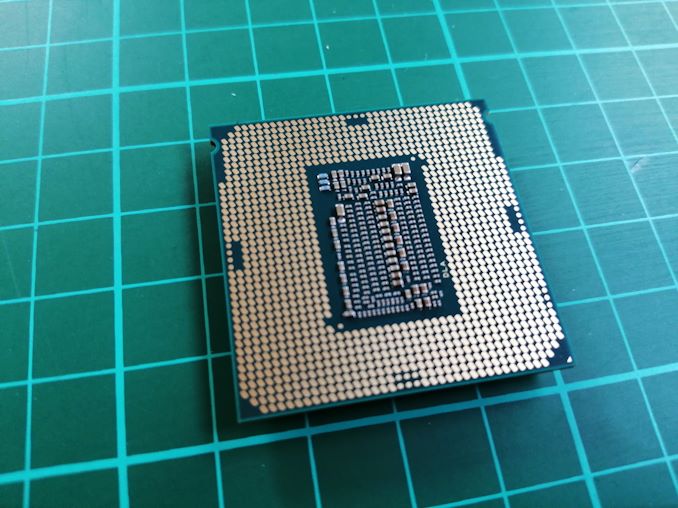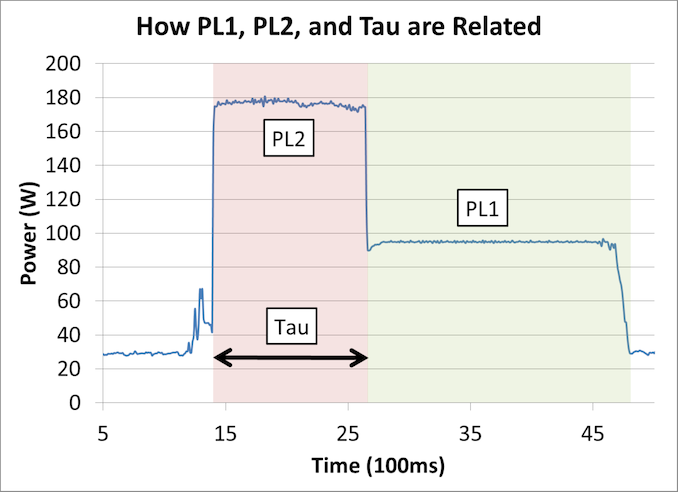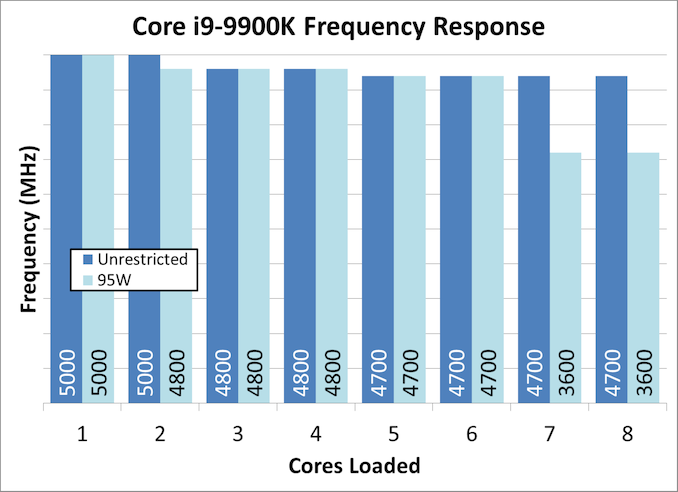The Intel Core i9-9900K at 95W: Fixing The Power for SFF
by Ian Cutress on November 29, 2018 8:00 AM EST
There is a lot of discussion about processor power recently. A lot of the issues stem around what exactly that TDP rating means on the box, and if it relates to anything in the real world. A summary of Intel’s official declaration boils down to TDP as the sustained processor power at long periods, however almost zero motherboards follow that guideline. As a result users will usually see much higher sustained power, although with much higher performance. Some small form factor systems rely on setting these limits, so we tested a Core i9-9900K with a 95W limit to see what would happen.
Intel and TDP
We recently published a sizeable analysis on what Intel officially means by TDP, and the associated values of PL1, PL2, and Tau. You can read it all here, although what it boils down to is this diagram:
When a processor is initially loaded, it should enter a state where PL2 describes the maximum power for a time of Tau seconds. When in this PL2 state, the CPU follows Intel’s per-core Turbo table rules, which reduces the frequency based on the number of cores loaded.
After Tau seconds, the CPU should drop down to a PL1 maximum sustained power value, which is usually identical to TDP. Depending on the CPU, this may reduce the frequency to the base frequency, or well below the all-core turbo frequency.
Technically PL2 is obtained over a moving average window, Tau, such that any low power moments on the processor will 'give budget back' to the turbo mode, however the graph above is the easiest way to see the high turbo mode on a fully loaded processor.
So while Intel defines a value for PL1, PL2, and Tau, almost zero consumer motherboard manufacturers actually follow it. There are many reasons why, mostly relating to overengineering the motherboards and wanting users to have the best performance at all times. The only times where these values follow any form of Intel guidance is in small form factor PCs.
For example, I tested an MSI Vortex G3 small form factor desktop at an event last year. It was using a processor normally rated for 65W TDP, and in a normal desktop that processor would push over 100W because the motherboard manufacturer in that system did not put any limits on the power, allowing the power to fall within Intel’s per-core turbo values. However, in this Vortex system, because of the limited thermal capabilities, the BIOS was set to run at 65W the whole time. This made sense for this form factor, but it meant that anyone looking for benchmarks of the processor would be misled – the power profile set in the BIOS was in no-way related to how that CPU would run in a standard desktop.
A Core i9-9900K with a 95W Limit
To put this into perspective, for this review we are using a Core i9-9900K which has a sustained TDP rating of 95W. When we compare the per-core frequencies of a 95W limited scenario and a normal ‘unrestricted scenario’, we get the following:
When a single core is loaded, the CPU is in 5.0 GHz mode as we are well under the power limit. There’s a slight decrease of 200 MHz in the 95W at two cores, but this disappears when 3-6 cores are loaded, with both setups being equal. The major difference happens however when we are at 7-8 cores loaded: because of the power consumption, the Core i9-9900K in 95W mode drops down to 3.6 GHz, which happens to be its base frequency.
This arguably means that we should see a correlation in most benchmarks between the two parts, but not if maximum load is ever required.
This Review
For this review, we’re putting the Core i9-9900K at a 95W power limit (as measured by the internal registers of the system) and running through our CPU test suite to see if how large the performance deficit is between the Core i9-9900K in a thermally unlimited scenario compared to a small form factor system deployment.
Pages In This Review
- Analysis and Competition
- Test Bed and Setup
- 2018 and 2019 Benchmark Suite: Spectre and Meltdown Hardened
- CPU Performance: System Tests
- CPU Performance: Rendering Tests
- CPU Performance: Office Tests
- CPU Performance: Encoding Tests
- CPU Performance: Legacy Tests
- Conclusions and Final Words












101 Comments
View All Comments
Alexvrb - Thursday, November 29, 2018 - link
Yes yes, all those office workers running a 9900K would barely notice. Serious, man? The whole reason this issue came to light was because gamers and other demanding users complained that the processor at DEFAULT settings on pretty much any retail board was annihilating TDP, even more noticeably so than their previous flagship. Journalists are lagging well behind, and when they DO bother looking into it, it's very much a "yeah it's true, shrug" article.Gastec - Wednesday, June 19, 2019 - link
Well said, "shrugging". Automagically overclocked CPU's do make benchmark graphs look better and CPUs sell better. Reminds me of one of AngryJoe's video about a certain MMO: "Oh, you want more? That would be $15 please! $15 more, please! That would be another $15!" Same with Intel, you want more performance, that would be 75% to 100% more watts, please! Yeah, I get it. Want 10 Ghz on all cores? 1000 W, what's the problem?koaschten - Thursday, November 29, 2018 - link
Check https://www.youtube.com/watch?v=kmAWqyHdebILindseyLopez - Wednesday, December 19, 2018 - link
nonicolaim - Thursday, November 29, 2018 - link
Missing link to TDP article on first page.Exodite - Thursday, November 29, 2018 - link
Thanks for this!It would be interesting, though perhaps not entirely related to this article in particular, to get a comparison on actual power draw and load temperatures as well. Similar to what you provide in your usual CPU reviews, to get a fair comparison to both the "unlocked" 9900K as well as the other slew of processors in the bench.
I'd imagine the 9900K would look much better on those numbers, though obviously worse on performance, when actually adhering to TDP.
Wingartz - Thursday, November 29, 2018 - link
*You can read it all [here], although what it boils down to is this diagram*[here] doesn't have a link to the article
:nudge> - Thursday, November 29, 2018 - link
For easy comparisons it's great to see Geekbench making an appearanceAlexvrb - Friday, November 30, 2018 - link
*worthless comparisons barely better Dhrystone and WhetstoneSirMaster - Thursday, November 29, 2018 - link
How many people are actually buying a $500 CPU and capping it's power limit to 95W?Can't be many, how about buy a different CPU if you plan on capping it's power limit like that.
I have an SFF mini-ITX build and my old overclocked haswell CPU is running at like 180W and staying cool just fine.